June 2018

The Minnesota Office for Soil Health
(MOSH) announces the selection of the first State Soil Health Specialist,
Anna Cates. This position provides expertise on soil health issues for
agricultural and conservation professionals across the state.
The Office for Soil Health is a
collaborative program created last year by the Board of Water and Soil
Resources (BWSR) in partnership with the University of Minnesota Water
Resources Center (WRC). The Office for Soil Health strives to build local
expertise to promote soil health and water conservation by developing the
knowledge, skills, and abilities of local conservationists to promote
sustainable soil and land management.
Anna Cates holds a Master of Science in
Soil Science and is finishing her doctorate in Agronomy from the University
of Wisconsin-Madison, where she has been studying soil carbon cycling in
corn-cover crop biofuel systems. She will begin her new role in a full-time
capacity in January 2019, but will work part-time until then to connect with
partners and stakeholders and plan outreach and research activities. Her position
will be housed within the Department of Soil, Water, and Climate at the
University of Minnesota.
“I’m eager to work closely with farmers,
keeping in mind the uncertainties of crop and livestock production,” Cates
said. “My goal is to tailor my research toward addressing the practicalities
of running a business.”
The Soil Health Specialist will expand
the tools and skills of Minnesota’s local conservation delivery community
through the development of research and outreach strategies, as well as
promote greater understanding of the economic impacts of soil and water
management practices. For more information, contact the Office for Soil
Health at (612) 624-6765.
Back to top
|
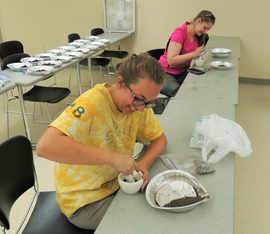
Research into healthier soil
that could support new agricultural practices in the region is moving forward with
the start of a three-year study in Mower County led by the local conservation
district. Mower Soil and Water Conservation District joined officials from Riverland
Community College and Hormel Foundation to launch the
soil-health research project – a major aspect of their growing partnership to
advance agricultural education and provide resources to farmers.
Lacking an adequate research
room at its Austin office, Mower SWCD reached out to Riverland for possible use
of the new lab space. Now that lab – which will be fully equipped by late
summer – has been getting used by Mower SWCD for storing and analyzing soil
samples taken from dozens of plots representing different types of farmland in
Mower County. Interest in cover
crops and other soil-health practices have been increasing in Mower County and
southern Minnesota but many local farmers want more data and scientific
evidence before making changes in their fields.
In
2017, Mower SWCD was approved for a $98,000 grant from The Hormel Foundation to
conduct soil-health research to look at the benefits of incorporating cover
crops and other soil-health practices into farm operations. About $200,000
overall, the project will match the Foundation’s grant with state “capacity”
funds given annually by the Minnesota Board of Water and Soil Resources
and in-kind services from partner agencies. Mower SWCD photo: Students work in soils lab at Riverland College.
Back to top
|
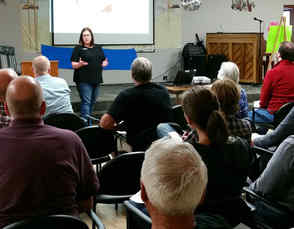
Willmar residents around a chain of lakes at the top of the Hawk Creek Watershed are reactivating a lake association focusing on water quality. About 50 gathered June 19 for the reboot, followed by a public meeting featuring various agency presentations.
Swan Lake and Willmar Lake main bay have been placed on the
state’s list of impaired waters because they exceed water quality standards
related primarily to excessive algae growth. Foot Lake still meets water
quality standards, but that could be threatened by receiving flow from Willmar
Lake.
In addition to the impact of pollutants in stormwater runoff,
concern is growing about the impact of invasive species. Large mats of curly
leaf pond weed appear to be increasing in all three lakes. Rough fish such as
carp stir up bottom sediment releasing phosphorus contributing to algae growth.
The public meeting featured short
presentations and information displays from local and state agencies including:
City of Willmar, Willmar Lakes Association, Kandiyohi Soil and Water
Conservation District, Hawk Creek Watershed Project, Dept. of Natural Resources,
and Pollution Control Agency.
Residents living near and around Willmar and Foot lakes can
participate in the “Adopt-a-Storm Drain” program. They can sign up online line at www.adopt-a-drain.org to adopt a storm drain and help to keep it
free from debris, and keep an eye out for illicit dumping. Photo: Hawk Creek Watershed Project Coordinator Heidi Rauenhorst speaking to the Willmar Lakes Association.
Back to top
|

The Cedar River Watershed District started a new season of Cedar Scenes photo contest and
will run it for nearly one month longer than in 2017 when it attracted more
than 300 images from 59 people over 16 weeks.
Cedar Scenes will run weekly –
photos submitted Monday to Sunday to count for a week – through Sept. 30 with a
goal of getting people outdoors and taking photos showing the Cedar River State
Water Trail or a tributary in the watershed district.
Runnings
in Austin once again is sponsoring the kayak grand-prize giveaway that will be
drawn in October. To qualify, each photo entered during the season for Cedar
Scenes will count as one entry for the kayak drawing. Weekly prizes will be
about $10 in value, such as Chamber Bucks to use at local businesses, with the
week’s winning photo picked by CRWD staff.
Photos can be submitted via CRWD’s
Facebook page – www.facebook.com/cedarriverwd
– by posting on the page, tagging CRWD or sending it in a message. Images also
can be emailed to tim.ruzek@mowerswcd.org
or brought to the CRWD office at 1408 21st Ave. N.W. in Austin
behind Runnings.
Back to top
|
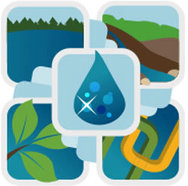
The DNR's the Watershed Health Assessment
Framework (WHAF)
is now able to deliver MPCA Water Quality Impairment and Assessment data that
is current through 2018. Through a coordinated effort with MPCA data
managers, several notable water quality data improvements and
enhancements have been made.
Impaired:
-
Impaired
Streams, 2018. Labels
all impairment types present for each stream reach. Label
includes the AUID suffix for each stream reach.
-
Impaired Lakes,
2018. Labels
all impairment types present for each water body. Legend tab shows symbology for each impairment
type. Individual layers are symbolized by impairment
types (with some grouping
Assessed:
- Layers are symbolized by assessment class and status;
for example: Assessed Streams, Aquatic Life Assessment, 2018
- Symbology
shows which assessed streams were found to be Fully Supporting, Insufficient
Information, Not Supporting for each Use Class
- ‘Add
Features’ legend tab will display these symbol definitions.
- Attached
document lists all the assessment data layers now available through the
WHAF.
Send us questions feedback to: whalf.dnr@state.mn.us.
Back to top
|
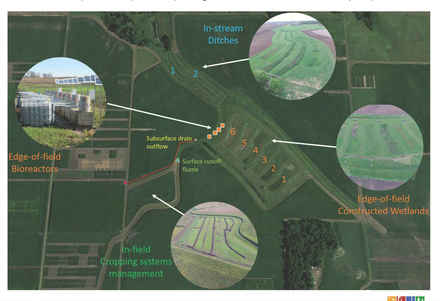
You are invited to attend a Drainage Water Management
Demonstration Tour at the University of Minnesota Southwest Research and
Outreach Center just west of Lamberton, Thursday Aug. 16. The field day is
being sponsored by the Southwest Research and Outreach Center and the College
of Food, Agricultural and Natural Resources Sciences with support from the
Minnesota Department of Agriculture, the Clean Water Land and Legacy Amendment
and the National Science Foundation. Goals are to share how single and
multiple drainage water management practices can help meet the Minnesota
Nutrient Reduction Strategy Goals for nitrogen and phosphorus from agricultural
runoff and drainage while maintaining farm productivity and profitability.
Back to top
|
 The 10th
Minnesota River Congress drew 87 basin-wide organizational
representatives and individuals to the Mankato Event Center May 17. The event kicked off
with the Networking Fair of displays and information from the Crystal Waters Project, Minnesota
Farmers Union, MPCA, DNR, LeSueur River Watershed Network, Mankato Paddling
and Outings Club, Paddle for Progress, Joseph Brown Center, Scott County, NRCS, Pioneer Public Television and River Ramble bike tour.
Congress facilitator Scott Sparlin recognized the various
sponsors of the Congress and team member Julie Beatty for her
work on the new web site. Congressman David Minge requested help with
identifying drainage improvement projects across
the basin. The Minnesota Division of the Izaak Walton League, Minnesota
Center for Environmental Advocacy and the Friends of the Minnesota Valley are
working to create a way for all proposed projects to be reported to a central
collection point to be made readily available for review, comment and if needed
action. He noted that if anyone was aware of such project they should
contact any of the organizations mentioned or they can contact the Minnesota
River Congress and it will be forwarded.
Chris Lenhart with the University of
Minnesota presented findings of a new report for the Izaak
Walton League looking at data previously collected on flow rates of the
river in a new way. It concluded that with the same approximate rates of
rainfall the river was receiving more water off the landscape and at an
accelerated rate. The only variables were increased intensity of rain
events and the increase of tile installation.
Jay Gustafson described his “Paddle for Progress” project to canoe and document each of the state water trails as designated
by the DNR. He plans on canoeing and documenting most or
all the others in 2018 and writing a report with recommendations when he is
finished. He encouraged people to report such things as lack of signage
or when an access is not accessible or in disrepair. He will be working to
increase accessibility to our river system in the future and to see more
opportunities for multiple day, family-oriented user safe trips.
Ron Bolduan, wildlife
photographer and explorer, and Scott Kudelka of the DNR showed numerous pictures and presented the wild side of
the river and people interacting with it.
Ann Lewandowski with the University of Minnesota described ia focus on increasing soil organic matter. She announced that she has been
appointed the new head of the Minnesota Office of Soil Health at the University.
Back to top
|
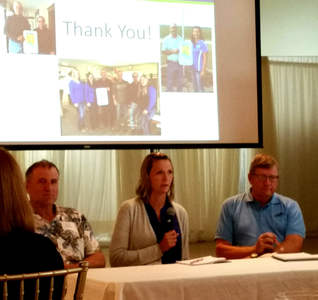
The Minnesota Agricultural Water Quality Certification program advisory committee met June 25 in Glenwood for a program update and testimonies from participating area farmers. Operated by the Dept. of Agriculture, it's a voluntary opportunity for farmers and agricultural landowners to take the lead in implementing conservation practices that protect our water. Photo L-R: Paul Freeman, Jessica Blair, State Rep. Paul Anderson.
"It's a chance to quantify the good things we are doing out there," says Paul Freeman, Pope County farmer. The sentiment was echoed by Grant Pearson, Stearns SWCD and certification specialist, "it's a opportunity to tell a positive story." Program director Brad Redlin offered a comparison with other conservation programs in terms of cost: "This is proving to be efficient in its use of dollars, the more farms certified the less it costs."
It uses a risk-assessment process where risks to water quality are identified and treated. When an identified risk is mitigated it is counted as a new practice. Farms that install and maintain approved farm management practices will be certified and in turn obtain regulatory certainty for a period of ten years. To date, 71 of Minnesota's 87 counties have at least one water-quality certified farm. Certification numbers as of June 18, 2018:
- 585 certified producers
- 371,107 certified acres
-
1,087 new practices implemented
Impact on water quality:
- 33,924 tons of soil saved per year
- 15,055 tons of sediment reduced per year
- 18,019 lbs. of phosphorus prevented per year
- Up to 49 % estimated reduction in nitrogen loss
Ag water quality certification program joins Field to Market
The Minnesota Agricultural Water Quality Certification Program has joined Field to Market: The Alliance for Sustainable Agriculture. Field to Market is a national organization working to meet the challenge of producing enough food, fiber, and fuel for a rapidly growing population while conserving natural resources. As a member in Field to Market, the MAWQCP will work together with grower organizations, academia, conservation groups, public sector partners, and leading companies at a national level to continue to improve water quality, water use efficiency, and land use efficiency while reducing soil erosion and greenhouse gas emissions.
Back to top
|
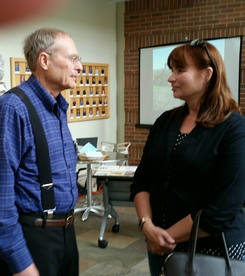
Successful
programs and progress sometimes can be taken for granted by those who follow
pioneers. In the realm of agricultural stewardship of soil and water, Les
Everett of the U of M's Water Resources Center is a prime example. A half-hour
at his retirement party May 23 barely gave enough time to review his work and
hear accolades from co-workers. A testament to his external relations
over the years, in addition to the University were friends and colleagues from
a variety of state and local agencies including BWSR, MPCA, MDA, and SWCDs.
A long table displayed the numerous publications that he worked
on over his 25 years the University. He managed a number of major projects
primarily in the areas of nutrient and manure management, feedlot rules, LiDAR,
and conservation tillage, detailed in various publications and web pages:
In 1973-75 he was a Peace Corps agricultural volunteer
in Africa before returning to earn an MS in agronomy at Cornell, and a PhD in
plant breeding at the U of M. He came to the University's Water Resources
Center in 1994 following 10 years of research in Africa with the International
Institute of Tropical Agriculture in Nigeria and Cameroon. Following his
retirement Les plans to remain in the area volunteering on projects and helping
at the family farm south of Grinnell, IA, and continue to assist with ag
research in Cameroon. Photo: Les chats with Jodi DeJong-Hughes of U of M
Extension.
Back to top
|
A series of public meetings with the Dept. of Agriculture will
present information about the proposed Groundwater Protection Rule (GPR) and
the rulemaking process. The meetings are informational only and not part of the official rulemaking
process. The process to submit formal comments and testimony that will become
part of the rulemaking record is a separate process from the informational
meetings. More information about the formal comment process is here. Meeting schedule:
- Monday, July 16, 1-6 p.m.,
Robert Boeckman Middle School,
800 Denmark Ave., Farmington
- Wednesday, July 18, 10 a.m.-4 p.m.,
Stewartville Civic Center,105 1st St E,
Stewartville
- Thursday, July 19, 10 a.m.-4 p.m.,
Minnesota West Community and Technical College,
1450 College Way,
Worthington
- Wednesday, July 25, 10 a.m.-4 p.m.,
River's Edge Convention Center,
10 Fourth Avenue S.,
St. Cloud
- Thursday, July 26, 9 a.m.-3 p.m.,
American Legion,
900 1st St E,
Park Rapids
Back to top

Juhl named BWSR communications coordinator
Mary Juhl recently joined the Board of Water and Soil Resources as the communications coordinator. Mary comes to BWSR from the Minnesota Senate, where she worked
as a legislative assistant for five years. She graduated from the University
of Missouri (Mizzou) School of Journalism and previously worked as a local
government reporter for the Winona Daily News and the Shakopee
Valley News. Mary is passionate about environmental issues and is excited
to join the BWSR team. In her free time, she enjoys hiking, volunteering, and
embroidery arts. She lives in the north metro with her fiancé, Christopher. Photo: Mary with a goat at the Minnesota Zoo.
|
Minnesota water research digital library update posted
The web address the Minnesota Water Research Digital Library (MNWRL) was incorrect in a previous newsletter. The correct URL is https://wrl.mnpals.net/. The library was recently enhanced, and at the same time doubled in size to now include over 2,600 peer-reviewed and non-peer-reviewed articles and reports (including “grey” literature that can be hard to find). The lead person at MDA for this project is Steve Roos (Agricultural Marketing and Development Division 651-201-6631, stephan.roos@state.mn.us).
Registration open for U of
M Field School for Ag Professionals July 25-26
The 2018 Field School for Ag Professionals will be July 25 - 26 at the University of Minnesota Agriculture Experiment Station on
the St.Paul campus. The school combines hands-on training
and real world field scenarios. The two-day program focuses on core principles in
agronomy, entomology, weed and soil sciences on the first day to build a
foundation for participants, and builds on this foundation with timely,
cutting-edge topics on the second day. More information.
'Conservation for a profitable farm' workshops offered
A series of workshops about "conservation for a profitable farm business" in the Shakopee Creek Watershed will provide farmers and landowners an opportunity to learn from other farmers and experts ways to support profitable farming while building healthy soils and maintaining clean water. Remaining workshops include:
- July 10, 9-noon, cover crops, Harold Stegeman farm, 370 110th St. SE, Benson.
- July 19, 9-noon, tilllage and soil health, Law Enforcement Center, 1410 Kansas Ave., Benson.
- Aug. 7, 4-7 p.m., integrating livestock into row crops, Kerkhoven Community Center, 301 10th St.
- Sept. 7, 4-7 p.m., farmland management, conservation legacy and working lands, Kerkhoven Community Center.
To register contact SWCD offices in Chippewa, Kandiyohi, or Swift counties, or Land Stewardship Project office in Montevideo, 320-269-2105.
EPA reports on coordination for nonpoint source measures in
hypoxia task force states
The Nonpoint Source Workgroup of the Hypoxia Task Force has
produced a summary of nutrient reduction measures among member states, and
critical metrics for tracking and informing progress toward reducing nutrient
loadings to the Gulf of Mexico. This document represents the first-ever report
that focuses on the Hypoxia Task Forceicoordinated effort to account
specifically for nonpoint source changes, primarily agricultural, that
influence nutrient loading from a variety of methods. To read the report and
learn how the Hypoxia Task Force and partners are supporting states in the
Mississippi River Basin to implement nutrient strategies and conservation
practices to reduce nutrient loadings contributing to hypoxia in the Gulf of
Mexico, visit: https://www.epa.gov/ms-htf/report-nonpoint-source-progress-hypoxia-task-force-states
.
Lego enthusiasts create model of Whitewater River watershed
A group of young Lego enthusiasts assembled this 3-D model of the Whitewater River watershed at the Whitewater State Park interpretive center. They worked on the project with Green Corps member Allison Bender along with Britt Gangeness of the MPCA. The Whitewater River and tributaries drain 205,000 acres in southeast Minnesota. The 26,000-piece Lego model is on tour at these locations: Winona Farmers Market, June 30; Winona County Fair, SWCD Booth, July 11-15; Olmsted County Fair, SWCD Booth, July 23-29. Keep track of its travels here. Photo by Katherine Logan. 90-second video of assembly - taken by Winona State University students.
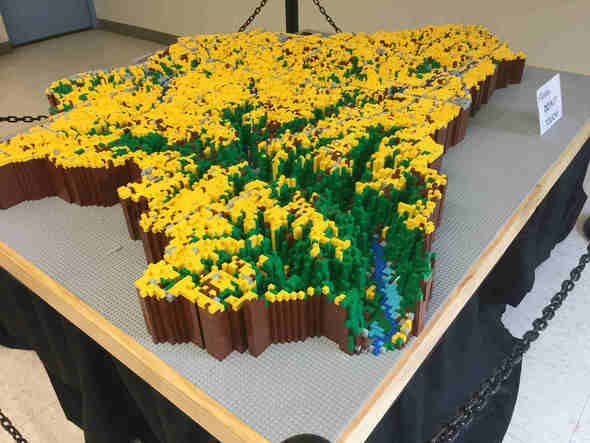 Back to top
|